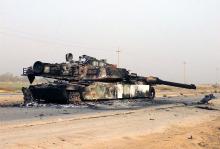Voices for Creative Nonviolence

In early April, the U.S. Navy unveiled its Mach 7 Magnetic Mangler, “a railgun straight out of Star Trek that can take out targets at 100 miles with a projectile flying at nearly 7,000 feet per second.” So far, the U.S. military has spent $240 million developing the railgun over a period of 10 years. CBS News reports that the railgun won’t go to sea until 2016, but one article, published in The Gazette, suggests that the U.S. military may have decided to show off the Magnetic Mangler in order to send a message to the Russian government.
In advance of the University of Wisconsin's recent “Resources for Peace” conference, a professor friend asked participants to consider whether the increasing competition for depleted global resources, for goods to meet essential human needs, would tend inevitably to make people less humane. She was thinking particularly about what she termed “the shrinking humanism” seen in dystopian novels and films that portray cruelty and violence among people who fear for their survival.
The fire in the Chaman e Babrak camp in Kabul, Afghanistan, began in Nadiai’s home shortly after noon. She had rushed her son, who had a severe chest infection, to the hospital. She did not know that a gas bottle was leaking; when the gas reached a wood-burning stove, flames engulfed her mud hut and extended to adjacent homes, swiftly rendering nine extended families homeless and destitute in the midst of already astounding poverty. By the time seven fire trucks had arrived in response to the fire at the refugee camp, the houses had burned to the ground.
No one was killed. When I visited the camp, three days after the disaster, that was a common refrain of relief. Nadiai’s home was on the edge of the camp, close to the entrance road. Had the fire broken out in the middle of the camp, or at night when the homes were filled with sleeping people, the disaster could have been far worse.
Even so, Zakia, age 54, who also lives in the camp, said this is the worst catastrophe she has seen in her life, and already their situation was desperate.

When she was 24 years old, in 1979, Fahima Vorgetts left Afghanistan. By reputation, she had been outspoken, even rebellious, in her opposition to injustice and oppression; and family and friends, concerned for her safety, had urged her to go abroad. Twenty-three years later, returning for the first time to her homeland, she barely recognized war-torn streets in urban areas where she had once lived. She saw and felt the anguish of villagers who couldn’t feed or shelter their families, and no less able to accept such unjust suffering than she’d been half her life before, Fahima decided to make it her task to help alleviate the abysmal conditions faced by ordinary Afghans living at or below the poverty line — by helping to build independent women’s enterprises wherever she could.